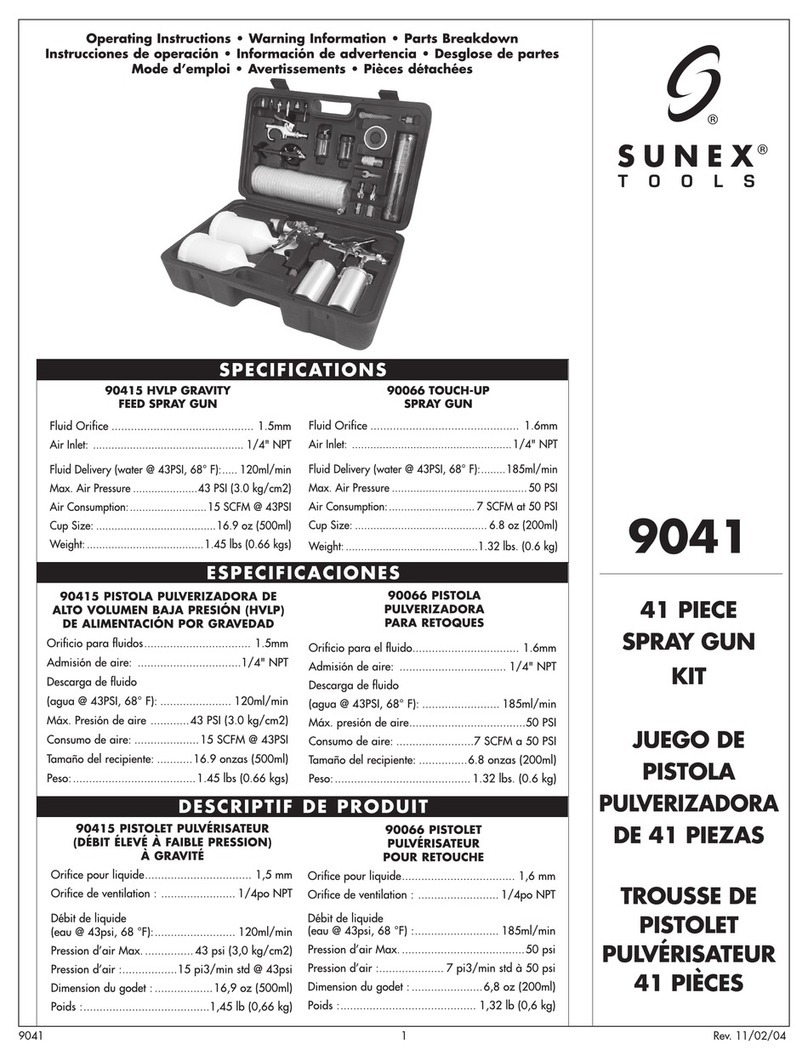
9002B Rev. A : Parts Breakdown & Operating Manual 2 03/07/13
To reduce the risk of injury, anyone using, repairing, maintaining, or changing accessories on this tool must
read and understand these instructions before performing any of these tasks.
Read THIS INSTRUCTION MANUAL Carefully and understand ALL
INFORMATION Before Operating THIS Tool. KEEP FOR FUTURE USE.
Always operate, inspect and maintain this spray gun in
accordance with American National Standards Institute Safety
Code of Portable Air Tools (ANSI B186.1) and any other applicable
safety codes and regulations.
During use and while cleaning and flushing spray gun solvents
can be expelled. Some solvents can cause eye injury. Always
wear eye protection.
Be sure all in the area are wearing impact-resistant eye and
face protection.
Even small projectiles can injure eyes and cause blindness.
High sound levels can cause permanent hearing loss. Protect
yourself from noise. Noise levels vary with work surface. Wear
ear protection.
Repetitive work motions, awkward positions and exposure to
vibration can be harmful to hands and arms.
Air under pressure can cause severe injury. Always shut off air
supply, drain hose of air pressure and disconnect tool from air
supply when not in use, before changing accessories or when
making repairs. Never direct air at yourself or anyone else.
Whipping hoses can cause serious injury. Always check for
damaged or loose hoses and fittings. Never use quick change
couplings at tool. They add weight and could fail due to vibration.
Instead, add a whip hose and connect coupling between air
supply and whip hose, or between whip hose and leader hose.
Do not exceed maximum air inlet pressure of 43 PSI.
Always use spray gun at a safe distance from other people in
work area.
Maintain spray gun with care. Keep tools clean and oiled for
best and safest performance. Follow instructions for lubricating
and changing accessories. Wiping or cleaning rags and other
flammable waste materials must be placed in a tightly closed
metal container and disposed of later in the proper fashion.
Do not wear loose or ill-fitting clothing; remove watches and rings.
Do not over reach. Keep proper footing and balance at all times.
Slipping, tripping and falling can be a major cause of serious
injury or death. Be aware of excess hose left on the walking or
work surface.
Do not abuse hoses or connectors. Never carry spray gun by the
hose or yank hose to disconnect from air supply. Keep hoses from
heat, oil and sharp edges. Check hoses for weak or worn condition
before each use, making certain that all connections are secure.
When possible, secure work with clamps or vise so both hands
are free to operate tool.
Solvent and paint coatings can be highly flammable when
sprayed. Adequate ventilation exhaust must be provided to keep
air free of accumulations of flammable materials. Smoking must
never be allowed in the spray area. Fire extinguishing equipment
must be present in the paint spray area.
Certain painting solvent materials may be harmful if inhaled, or if
there is contact with the skin. Always follow the requirements of
the Material Safety Data Sheet supplied by your coating material
manufacturer. Adequate exhaust ventilation must be provided to
keep the air free of accumulations of toxic materials. Always use a
mask or respirator whenever there is a chance of inhaling sprayed
materials. The mask must be compatible with the material being
sprayed and its concentration. Respirator equipment must be
NIOSH approved.
Halogenated hydrocarbon solvents - for example: methylene
chloride and 1,1,1,-Trichlorethene are not chemically compatible
with the aluminum that might be used in spray gun components.
The chemical reaction caused by these solvents reacting with
aluminum can become violent and lead to an equipment
explosion. Guns with stainless steel internal passageways may
be used with these solvents. However, aluminum is widely used
in other spray application equipment. Check all equipment items
before use and make sure they can also be used safely with these
solvents. Read the label or data sheet for the material you intend
to spray. If in doubt as to whether or not a coating or cleaning
material is compatible, contact your material supplier.
Spray gun operators should be given adequate training in the
safe use and maintenance of the equipment. Users must comply
with all local and national codes of practice and insurance
company requirements governing ventilation, fire precautions,
operation, maintenance, and housekeeping. These are OSHA
Sections 1910.94 and 1910.107 and NFPA-33.
Use of spray guns may cause cumulative trauma disorders
(CTD's). CTD's, when using spray guns, tend to affect the upper
extremities. Factors which may increase the risk of developing a
CTD include:
1. High frequency of the activity.
2. Excessive force, such as gripping, pinching, or pressing
with the hands and fingers.
3. Extreme or awkward finger, wrist, or arm positions.
4. Excessive duration of the activity.
5. Vibration.
6. Repeated pressure on a body part.
7. Working in cold temperatures.
CTD's can also be caused by sports activities. Pain, tingling, or
numbness in the shoulder, forearm, wrist, hands, or fingers,
especially during the night, may be early symptoms of a CTD.
Do not ignore them. Should you experience any such symptoms,
see a physician immediately. Other early symptoms may include
vague discomfort in the hand, loss of manual dexterity, and
nonspecific pain in the arm. Ignoring early symptoms and
continued repetitive use of
the arm, wrist, and hand can lead
to a serious disability.
SAFETY INSTRUCTIONS - DO NOT DISCARD - GIVE TO USER

























